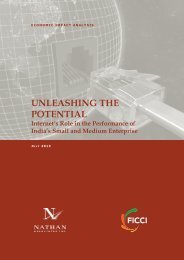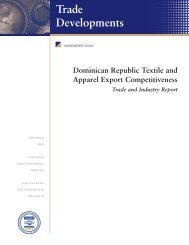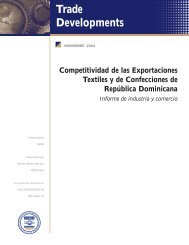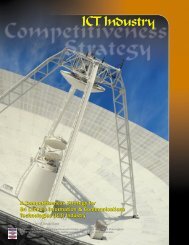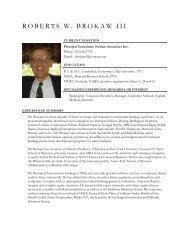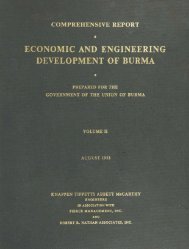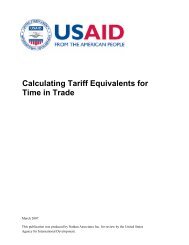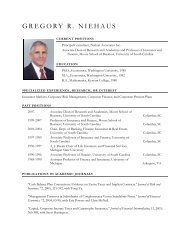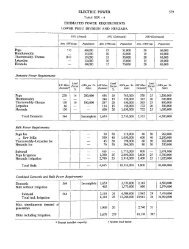Putting it to Work in Developing Countries - Nathan Associates
Putting it to Work in Developing Countries - Nathan Associates
Putting it to Work in Developing Countries - Nathan Associates
Create successful ePaper yourself
Turn your PDF publications into a flip-book with our unique Google optimized e-Paper software.
4. FDI DRIVERS AND<br />
FUTURE DIRECTIONS<br />
Macroeconomic forces, global production<br />
cha<strong>in</strong>s, technology advances, and host-country<br />
cond<strong>it</strong>ions broadly determ<strong>in</strong>e the size and location<br />
of foreign direct <strong>in</strong>vestment throughout the<br />
world. The result is a constantly shift<strong>in</strong>g set of<br />
sec<strong>to</strong>ral and <strong>in</strong>dustry dest<strong>in</strong>ations for FDI. But<br />
w<strong>it</strong>h<strong>in</strong> these shifts, two fundamental trends have<br />
emerged. First, service sec<strong>to</strong>r activ<strong>it</strong>ies now<br />
attract a major<strong>it</strong>y of FDI <strong>in</strong>flows, globally and<br />
<strong>in</strong> develop<strong>in</strong>g countries. Second, develop<strong>in</strong>g<br />
countries as a group are <strong>in</strong>creas<strong>in</strong>g their share of<br />
worldwide FDI s<strong>to</strong>ck <strong>in</strong> all sec<strong>to</strong>rs, but not <strong>in</strong><br />
all <strong>in</strong>dustries w<strong>it</strong>h<strong>in</strong> sec<strong>to</strong>rs. These sec<strong>to</strong>r and<br />
<strong>in</strong>dustry trends, comb<strong>in</strong>ed w<strong>it</strong>h other fac<strong>to</strong>rs<br />
especially relevant <strong>to</strong> develop<strong>in</strong>g economies—<br />
the end of the Multifibre Arrangement, the<br />
dom<strong>in</strong>ance of Ch<strong>in</strong>a, the need <strong>to</strong> upgrade <strong>in</strong>frastructure<br />
systems, and <strong>in</strong>creas<strong>in</strong>g South-South<br />
<strong>in</strong>vestment l<strong>in</strong>ks—will shape future FDI <strong>in</strong>flows<br />
<strong>in</strong> develop<strong>in</strong>g countries.<br />
PROFILE OF FDI BY SECTOR<br />
Worldwide FDI patterns have shifted markedly<br />
over the past 15 years. Compar<strong>in</strong>g the 1990 and<br />
2004 compos<strong>it</strong>ion of <strong>in</strong>ward FDI s<strong>to</strong>ck <strong>in</strong> develop<strong>in</strong>g<br />
and developed countries, at the sec<strong>to</strong>ral<br />
and then the <strong>in</strong>dustry level, is reveal<strong>in</strong>g. 1<br />
DOMINANT ROLE OF SERVICES<br />
Perhaps contrary <strong>to</strong> expectation—given popular<br />
images of Ch<strong>in</strong>a’s vast FDI-fueled manufactur<strong>in</strong>g<br />
<strong>in</strong>dustry—the services sec<strong>to</strong>r now accounts<br />
for the largest share of <strong>in</strong>ward FDI s<strong>to</strong>ck <strong>in</strong><br />
develop<strong>in</strong>g countries. The sec<strong>to</strong>r consists of conventional<br />
services, such as power, water, and<br />
other public util<strong>it</strong>ies; telecommunications;<br />
f<strong>in</strong>ance and <strong>in</strong>surance; and retail and wholesale<br />
distribution. It also <strong>in</strong>cludes the new services of<br />
bus<strong>in</strong>ess support and other activ<strong>it</strong>ies enabled by<br />
telecommunications and IT.<br />
In develop<strong>in</strong>g countries, FDI <strong>in</strong> services<br />
<strong>in</strong>creased substantially <strong>in</strong> the second half of the<br />
1990s, grow<strong>in</strong>g at a much faster rate than FDI<br />
<strong>in</strong> manufactur<strong>in</strong>g or natural resources. Services<br />
now represent nearly 60 percent of <strong>to</strong>tal <strong>in</strong>ward<br />
FDI s<strong>to</strong>ck, up from 47 percent 15 years ago.<br />
Manufactur<strong>in</strong>g represents roughly 30 percent, a<br />
decrease of nearly 15 po<strong>in</strong>ts. Inward FDI s<strong>to</strong>ck<br />
<strong>in</strong> natural resources has also grown slightly <strong>in</strong><br />
absolute and relative terms, but <strong>it</strong>s share of 8<br />
percent is still the smallest of the three sec<strong>to</strong>rs<br />
(Table 4-1). This evolv<strong>in</strong>g sec<strong>to</strong>ral compos<strong>it</strong>ion<br />
roughly parallels what has happened <strong>in</strong> the<br />
developed world <strong>in</strong> the same period, where concentration<br />
of FDI <strong>in</strong> services is a b<strong>it</strong> higher<br />
39



